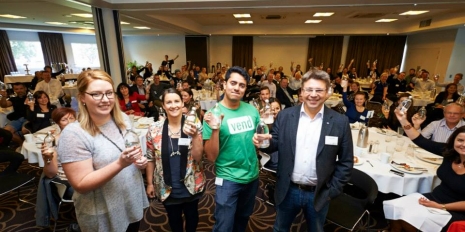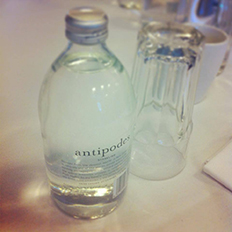
It was a beautiful sunny morning to talk social media at the Air New Zealand E.A.T Breakfast hosted by ExportNZ Bay of Plenty. Four professionals spoke on social media, and although they all claimed they were not ‘experts’ in social media, they all shared some vital insights to how they use various channels alongside their marketing strategies.
First up was Antipodes Water sales manager Morven McAuley (@antipodes_water). Antipodes was founded in New Zealand ten years ago with the goal to bring the 100% Pure NZ image full circle, where it was already represented by the food and wine industry, to include water. Founder Simon …. Tapped into the deepest aquifer in New Zealand, to find a water with a good mineral flavor that can be bottled without the use of chemicals. This clean green image is evident in their packaging – a simple glass bottle with clean type based label – and carries through their social media presence. And without a showroom to sell from and just a small 5 person team, media is an incredibly important tool which Antipodes uses to spread their message to the world.
Morven uses three main venues to host their communications: Facebook, Twitter, and Instagram. Uniting these channels is the ability to gain feedback and answer questions about the product and one of the best ways to provide customer service to her clients around the world. Using Facebook as a magazine style promotion, she shares information in various sections like food, wine, and fashion to get a broad reach amongst fans. It is important to Antipodes to respect their followers and does so by avoiding over promotion and competition, things that might discount the brand.

Twitter is more of a grapevine, a place to read and share gossip. Morven has learned a lot by following heavy hitters like Lady Gaga, who, in turn, gave unsolicited promotion of the brand. Starting a tweet-driven conversation with Gaga lead to the delivery of the water to her Melbourne suite. She tweeted a picture to her fans, causing a flurry of photos of fans drinking the water. This kind of emotional connection is vital to create and maintain good connections with your followers.
Similarly, building relationships is Morven’s biggest motivation on Instagram. Lucky to have a physical product, and such a photogenic one at that, she also follows potential customers to look out for opportunities to gain a connection. After posting a photo I took that morning, I got an instant comment from a friend whose parents live near the Antipodes plant. I mentioned this to Morven, who remembered a comment from the same friend on her photo of the plant mailbox. Digital media seems to make the world a little bit smaller and a little friendlier when we can connect, share our stories, and build relationships.
After a short breakfast break we heard from Sim Ahmed, community manager for Vend (@VendHQ, @Simantics), who got his job in social media by using social media. Vend is point-of-sale, inventory and customer loyalty software founded in NZ and uses social media as a promotional tool. Starting out, they didn’t have the money for a big advertising campaign. To get their name into the US market, for example, can be quite expensive, so social media is a great ‘free’ way to spread the word.
For Vend, it’s important to use social media not just for marketing. Social media can be used to gain insight and answer feedback from customers. Sometimes things will go wrong; comments might not always be positive, but using social media to help your customers, not just yourself, is important. Social media feedback is the modern business community’s way of making up for call centres. Communications have to be two-way, answered from a human, not a robot. Therefore your social media manger needs to be passionate and know the brand in order to give the right messages.
Other ways that vent uses social media are by utilizing LinkedIn for recruitment – Sim’s job was advertised by using a comic – and Instagram for sharing the culture of the company. While these pictures often involve beer, cake, and cats, this is an accurate insight to Vend’s internal culture and to show that they’re not just programmers, but that they’re people too.
Next on the podium was Jonathan Allan GM Marketing for Xero (@Xero, @JonAllan_NZ), the up and coming cloud accounting software that’s firing up the country. Jon’s history as a direct marketer in telesales meant that the world of social media was quite daunting to him at first. A lightblub moment that drew him into social media and made him realized its importance was when he met a collegue, Sara. He shared a great feedback story where Sara had received bad service at a hotel – a double charge for wifi – and tweeted about it. She got instant face-to-face feedback from the hotel manager and a refund. This opened Jon’s eyes to the power of social media as a way to connect and interact with customers. Today, rather than simply a tactic or passing fad, Jon sees the need for social media to be incorporated into his business model and to make organisations more social. Employees are requested to be active, but remember to represent the company and brand values. Currently there are just four people who can talk on behalf of Xero in the social arena, and their communications are scheduled to avoid interference and mixed messages.
If you’re putting yourself out there you have to be able to respond. Chief Executive / Executive Director Rod Drury is a great example of this, and is very active and informative through social media. But he doesn’t let his corporate standing get in the way – he understands that you have to use your own voice to connect with followers.
Xero aims not only to connect but also to spread knowledge. Seeing the lack of information about accounting online and the number of YouTube searches for accounting, they created an online library of small business guides. These not only bring people to the Xero site, but were created to be shared and spread around. Through this channel alone they’ve gained over 300 customers – exponentially more than would have been gained using a direct marketing campaign and sharing with a short list of people. Seeing the power of social media sharing and the future that is video, their next venture is in Xero TV, help guides and hero videos to spread information and messaging. As Jon put it: “Video is where it’s at.”
Lastly we got some quick tips and trends from Cucumber’s marketing manager Clare Swallow (@CucumberNZ, @ClareSwallow).
Her top five tips are:
• Have a plan (that you can articulate in 30 seconds or less). Goals are vital to any strategy, and social media is no exception. You need to understand your audience and approach, know what tools and platforms you will use and what direction you want to take on.
• Be where your customers are. Having a Facebook account doens’t mean that you’ll win at social media. It’s all about the activity that you’re putting out there.
• Choose your weapon. Be transparent about your message and own the feedback you get – good or bad. Be human, and respond in a way that shows you care.
• Everything changes all of the time – get used to it.
• Think ‘would I share this?’ before posting on behalf of your company. If something is too lame or obscure for you to care about then your followers will probably agree.
Clare also spoke about three upcoming trends in social media. The first was evident in the other three speakers’ presentations: invest in social media. It is becoming less of a luxury and more of a necessity, not just for your marketing strategy but for your brand’s image and feedback stream. For some companies, this means a full time position; for others it will be a daily task, simple as checking email. Morven McAuley for example spends 4-5 hours each week on social media but has a great presence. Instagram, Facebook, and Twitter are tools she uses every day, so it is ingrained in what she does.
The second is that Google+ is working its way up the chain of major social media platforms. Google is already top on the short list of search engines, and will start using Google+ data to drive searches. And lastly, text is no longer enough. This is obvious with the rise in Instagram’s popularity, but photos and video are fast becoming more common across other platforms. It appears our media hungry society is craving more than just words (or tweets) on the page.
We use our social media channels to share ideas around innovation, successes of our clients and ourselves, and to spread information about what we do. How does social media work for your business?
Here are some links if you’d like to follow us:
Facebook: www.facebook.com/locusresearch
Twitter: @LocusResearch
LinkedIn: www.linkedin.com/company/locus-research-ltd
Google+: http://gplus.to/LocusResearch
Comments
Post new comment